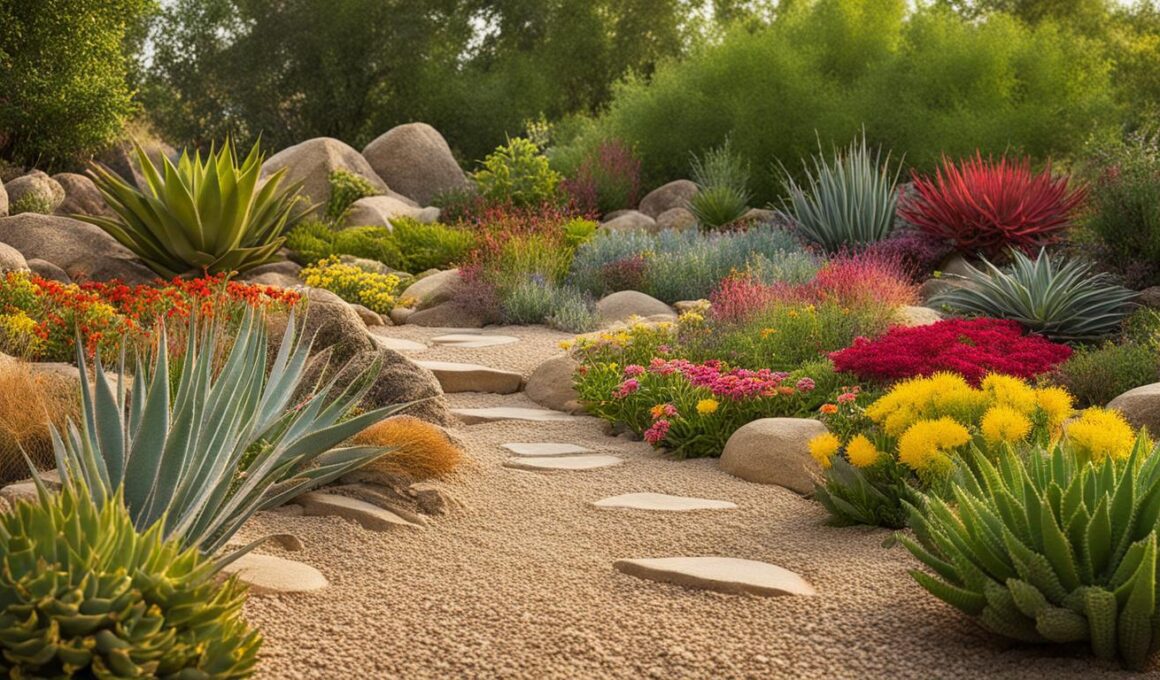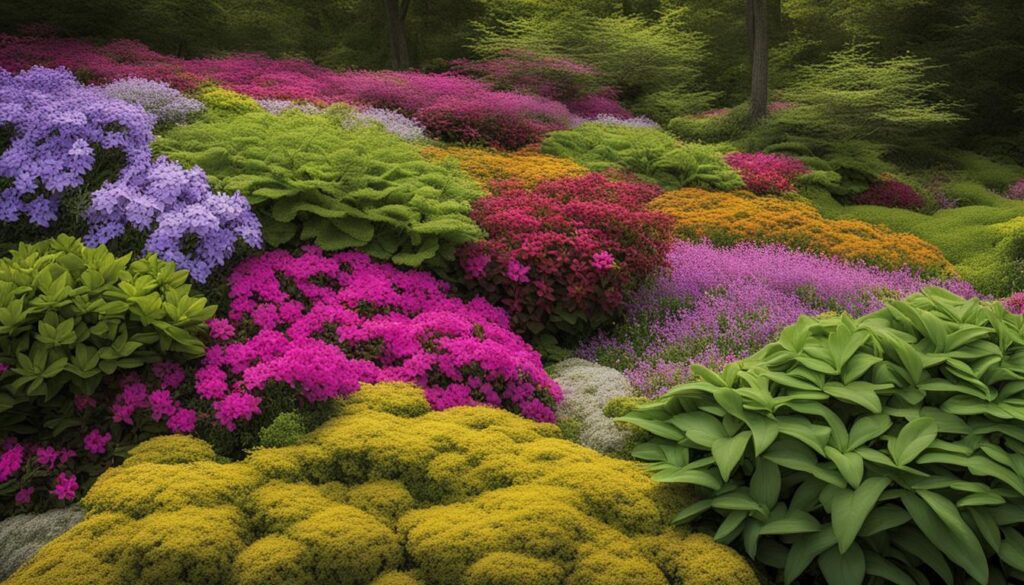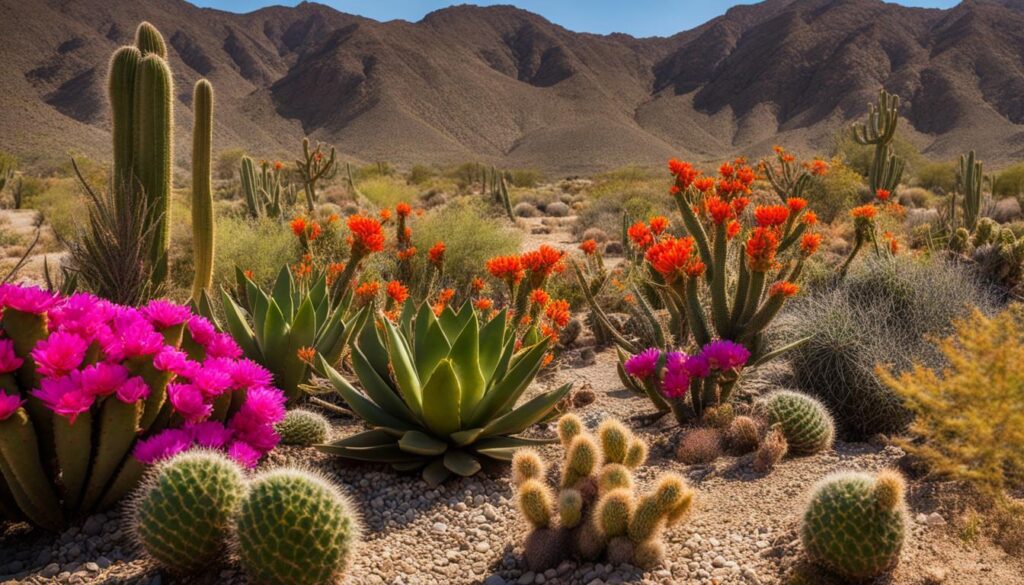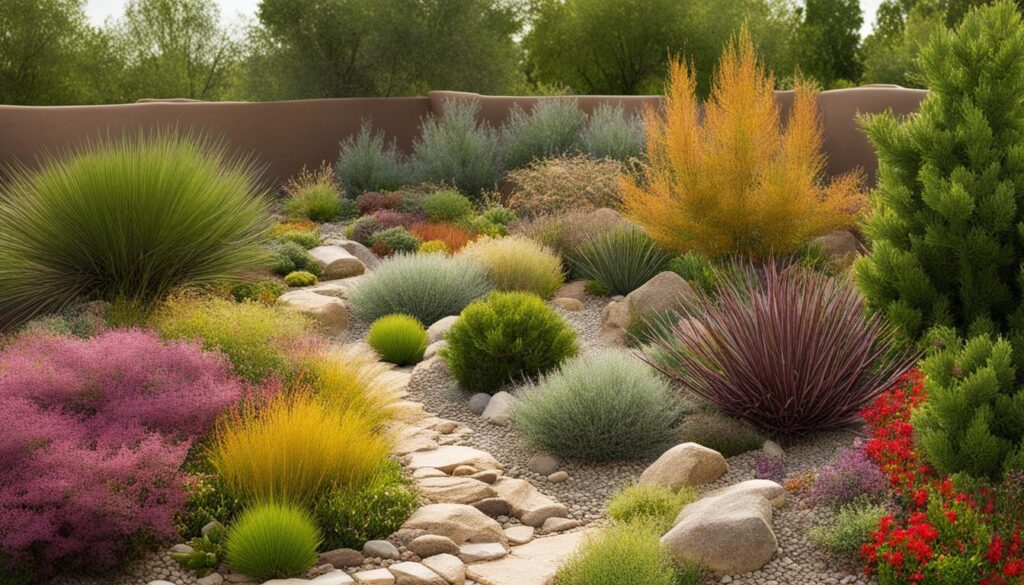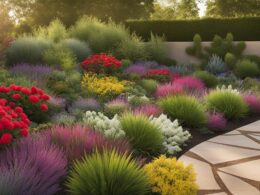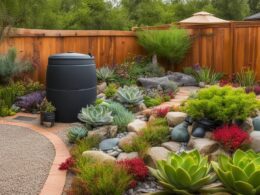Xeriscaping is a low-water gardening technique that has gained popularity in the US, particularly in arid regions like the West coast. Contrary to popular belief, xeriscape gardens can be visually appealing and diverse, incorporating a wide variety of plants, from succulents to flowering shrubs. By following xeriscaping principles such as careful planning, limiting turfgrass, and choosing plants with lower water needs, homeowners can create a sustainable and water-efficient landscape. Let’s explore some of the best native plants for xeriscaping in the US, focusing on their size, watering frequency, and light requirements.
Key Takeaways:
- Choose native plants for xeriscaping to ensure they are adapted to the local climate and require less water.
- Xeriscaping can create visually appealing and diverse gardens, incorporating a variety of plants.
- By following xeriscaping principles, homeowners can create a sustainable and water-efficient landscape.
- Consider the size, watering frequency, and light requirements of native plants when selecting for a xeriscape garden.
- Xeriscape gardens can be low-maintenance and help conserve water resources.
Ground Covers and Fairy Gardens
Ground covers are an essential component of xeriscape gardens, providing not only visual interest but also aiding in water conservation. These low-growing plants help to minimize soil erosion, retain moisture, and reduce water evaporation. Incorporating native ground covers in your xeriscape garden is a great way to create a visually appealing and sustainable landscape.
Some excellent native ground covers suitable for xeriscaping include:
- Sedum rubrotinctum (‘Pork And Beans’): This succulent ground cover features vibrant green leaves that turn to shades of red and orange under stress. It is drought-tolerant and thrives in zones 5-11.
- Pachysandra procumbens (‘Allegheny Spurge’): A shade-loving ground cover with unique purple-brown flowers in early spring. It thrives in zones 5-9 and is perfect for adding texture and color to your xeriscape garden.
- Ophiopogon japonicus (‘Dwarf Lilyturf’): This grass-like ground cover forms dense clumps of dark green foliage and produces delicate spikes of white or lilac flowers. It is adaptable to a wide range of soil conditions and thrives in zones 6-11.
- Ophiopogon planiscapus (‘Black Mondo Grass’): A striking ground cover with black, grass-like foliage that adds contrast to your xeriscape garden. It produces small pink or white flowers and thrives in zones 6-11.
These ground covers not only help conserve water but also create an ideal environment for fairy gardens. By incorporating miniature furniture, accessories, and natural elements like small stones and driftwood, you can create a whimsical and enchanting fairy garden within your xeriscape landscape.
| Plant | Description | Zones |
|---|---|---|
| Sedum rubrotinctum (‘Pork And Beans’) | Succulent ground cover with green leaves turning red and orange under stress. | 5-11 |
| Pachysandra procumbens (‘Allegheny Spurge’) | Shade-loving ground cover with purple-brown flowers in early spring. | 5-9 |
| Ophiopogon japonicus (‘Dwarf Lilyturf’) | Grass-like ground cover with dark green foliage and white or lilac flowers. | 6-11 |
| Ophiopogon planiscapus (‘Black Mondo Grass’) | Striking ground cover with black foliage and pink or white flowers. | 6-11 |
Dwarf Lilyturf (Ophiopogon japonicus)
One standout ground cover option for xeriscaping is the Dwarf Lilyturf (Ophiopogon japonicus). This grass-like ground cover forms dense clumps of dark green foliage, providing an attractive contrast to other plants in your xeriscape garden. It is a versatile plant that can adapt to a wide range of soil conditions and light levels, making it suitable for various garden settings.
In addition to its visually appealing foliage, the Dwarf Lilyturf produces delicate spikes of white or lilac flowers in the summer, adding further interest to your xeriscape landscape. This ground cover is also relatively low-maintenance, requiring minimal watering once established. It thrives in zones 6-11, making it suitable for many regions across the US.
The Dwarf Lilyturf (Ophiopogon japonicus) is a versatile and visually appealing ground cover option for xeriscaping. Its dark green foliage and delicate flowers add interest to your landscape with minimal maintenance requirements. Thriving in zones 6-11, this grass-like ground cover is an excellent choice for creating a sustainable and water-efficient xeriscape garden.
Whether you’re looking to conserve water or create a visually enchanting landscape, incorporating native ground covers in your xeriscape garden is a fantastic way to achieve both. These plants not only help retain moisture in the soil but also provide a beautiful and sustainable ground cover option. From succulents like Sedum rubrotinctum to grass-like species like Ophiopogon japonicus, there are a wide variety of native ground covers available to suit your xeriscaping needs.
Drought-Tolerant Flowers for Xeriscaping
Xeriscape gardens can also incorporate vibrant and drought-tolerant flowering plants. By choosing native perennials that thrive in arid conditions, you can enjoy a stunning display of color while conserving water. Here are some top choices for drought-tolerant flowers in xeriscaping:
- Aloe aristata (‘Lace Aloe’) – Known for its unique rosette shape and orange flowers, this succulent is a hardy choice for xeriscape gardens.
- Erigeron karvinskianus (‘Santa Barbara Daisy’) – With delicate white and pink flowers that bloom year-round, this daisy-like plant adds a touch of whimsy to any garden.
- Euphorbia myrsinites (‘Myrtle Spurge’) – This low-growing succulent features vibrant yellow flowers and blue-gray foliage, creating a striking contrast in xeriscapes.
- Callirhoe involucrata (‘Purple Poppy-Mallow’) – With its beautiful purple flowers and sprawling growth habit, this native perennial adds a touch of elegance to xeriscape gardens.
These drought-tolerant flowers are not only beautiful but also require less water compared to traditional garden plants. By incorporating them into your xeriscape design, you can create a vibrant and sustainable landscape that thrives in arid regions.
Benefits of Drought-Tolerant Flowers in Xeriscaping
Choosing drought-tolerant flowers for xeriscaping offers several benefits:
- Water Conservation: Drought-tolerant flowers require less water, helping you reduce water consumption and conserve this precious resource.
- Low Maintenance: These flowers are adapted to survive in dry conditions, making them low-maintenance and saving you time and effort in garden upkeep.
- Attract Pollinators: Many drought-tolerant flowers are highly attractive to bees, butterflies, and other pollinators, supporting local ecosystems and biodiversity.
- Visually Pleasing: Drought-tolerant flowers come in a range of vibrant colors and unique shapes, adding beauty and visual interest to your xeriscape garden.
By incorporating drought-tolerant flowers into your xeriscape design, you can create a stunning landscape that not only conserves water but also attracts pollinators and enhances the beauty of your outdoor space.
Xeriscape Shrubs for Structure and Texture
When it comes to creating a visually appealing and sustainable xeriscape garden, incorporating shrubs is essential. Shrubs provide structure and texture, adding depth and interest to your landscape. They can also serve as focal points or create natural barriers. Here are some excellent choices for xeriscape shrubs that are drought-tolerant and native to the US:
Salvia chamaedryoides (‘Germander Sage’)
This shrub is known for its stunning blue flowers and gray-green foliage. It thrives in full sun and well-drained soil and requires minimal water once established. ‘Germander Sage’ is extremely drought-tolerant and can withstand hot and dry conditions, making it ideal for xeriscape gardens in arid regions.
Juniperus conferta (‘Shore Juniper’)
With its low-growing and spreading habit, ‘Shore Juniper’ is an excellent choice for ground cover or as a border plant. It has dense, dark green foliage that adds texture to your landscape. This shrub is highly adaptable and can tolerate a wide range of soil and light conditions, including full sun and partial shade.
Rohdea japonica (‘Japanese Sacred Lily’)
‘Japanese Sacred Lily’ is a versatile shrub that features evergreen leaves with a glossy texture. It produces small flowers and red berries, adding visual interest to your xeriscape garden. This shrub thrives in shade or partial shade, making it an excellent choice for areas with limited direct sunlight.
By incorporating these xeriscape shrubs into your garden, you can create a visually stunning and low-maintenance landscape that conserves water and thrives in arid conditions. Remember to choose native species that are adapted to your climate zone for the best results.
Drought-Tolerant Plants for Xeriscaping: Cacti and Succulents
When it comes to xeriscaping, cacti and succulents are the stars of the show. These plants are not only visually stunning but also highly adapted to survive in arid conditions. With their ability to store water in their leaves and stems, they require minimal watering and can thrive in even the driest of climates. Incorporating these drought-tolerant plants into your xeriscape garden will not only add a touch of unique beauty but also reduce your water usage.
One popular choice for xeriscaping is the Sedum kamtschaticum, also known as the ‘Russian Stonecrop.’ This small succulent boasts clusters of bright yellow flowers that bloom in the summer, adding a pop of color to your garden. Its low-growing habit makes it perfect for ground covers or rock gardens. Another attractive option is the Aloe brevifolia, or ‘Crocodile Aloe,’ which features distinctive gray-green leaves with white spots. This eye-catching succulent adds texture and visual interest to any xeriscape garden.
“Xeriscaping with cacti and succulents not only conserves water but also creates a unique and visually appealing landscape.” – Xeriscape enthusiast
If you’re looking for a statement plant, consider the Agave ovatifolia, or ‘Whale’s Tongue Agave.’ This architectural succulent has large, fleshy leaves that form a rosette shape, creating a dramatic focal point in your garden. Its silver-blue color adds a cool and serene element to the landscape. Pair it with other succulents or low-growing ground covers to enhance its visual impact.
Overall, incorporating cacti and succulents into your xeriscape garden is a smart choice. Not only do these plants require minimal watering, but they also come in various sizes, shapes, and colors, allowing you to create a diverse and captivating landscape. Whether you choose small sedums for ground covers or large agaves for a bold statement, these drought-tolerant plants will thrive in your xeriscape garden and add unique beauty to your outdoor space.
| Plant | Common Name | Key Features | Climate Zones |
|---|---|---|---|
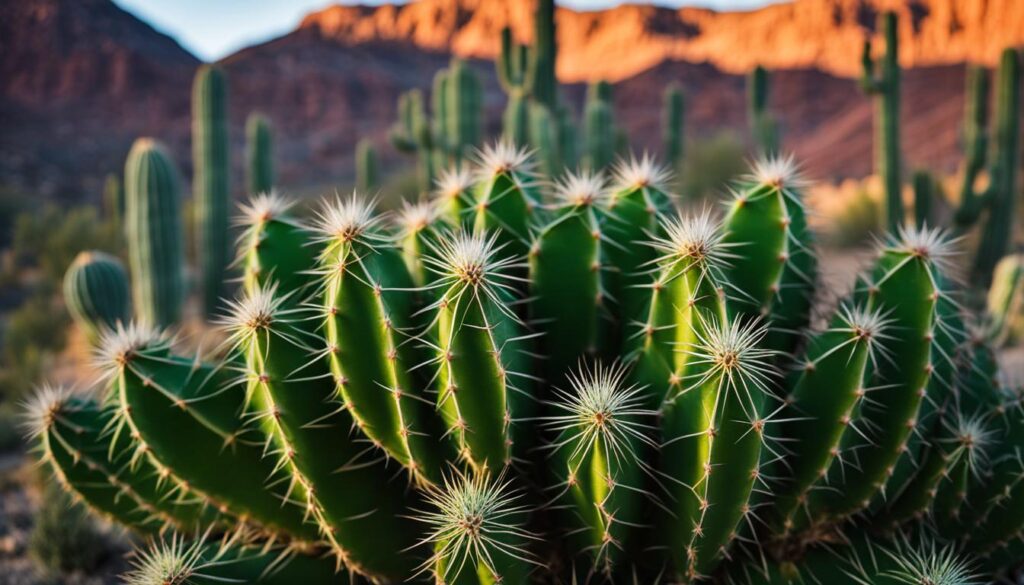 |
Sedum kamtschaticum | Bright yellow flowers, low-growing habit | 3-11 |
 |
Aloe brevifolia | Gray-green leaves with white spots | 3-11 |
 |
Agave ovatifolia | Silver-blue fleshy leaves, dramatic rosette shape | 5-11 |
Conclusion
Xeriscaping offers a multitude of benefits that make it an excellent choice for creating a low-water, water-efficient garden. By incorporating the best native plants for xeriscaping, you can enjoy a visually appealing landscape while minimizing water usage and maintenance requirements.
One of the key advantages of xeriscaping is its ability to reduce water consumption. By carefully selecting plants with lower water needs and implementing water-saving techniques, such as limited turfgrass and strategic irrigation, you can significantly cut down on your water usage without compromising on the beauty of your garden.
In addition to conserving water, xeriscaping also offers the advantage of lower maintenance requirements. Native plants are naturally adapted to the local climate and soil conditions, making them more resistant to pests and diseases. This means less time and effort spent on fertilizing, watering, and pruning, allowing you to spend more time enjoying your garden.
Transform your garden into a water-efficient paradise with xeriscaping. Embrace the benefits of low-water landscaping and create a sustainable landscape that not only enhances the beauty of your home but also contributes to the conservation of water resources. With the wide variety of ground covers, flowers, shrubs, and succulents available for xeriscaping, you can design a garden that suits your personal style and thrives even in arid regions of the US.





